Thompson Family Cemetery
On White Settlement Road less than fifty feet from the tenth tee at Hawks Creek Golf Club is Thompson Family Cemetery, population twelve. (See Part 1.)
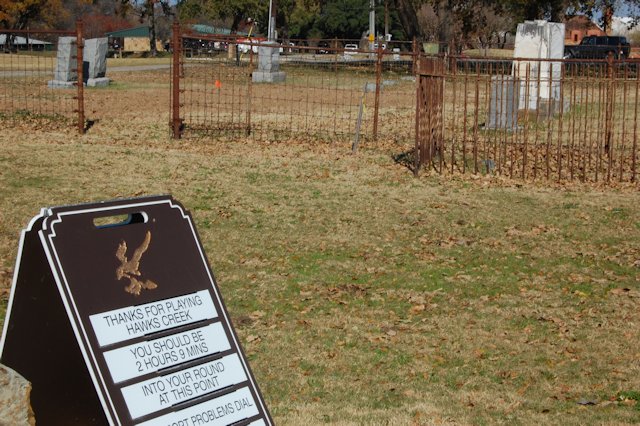
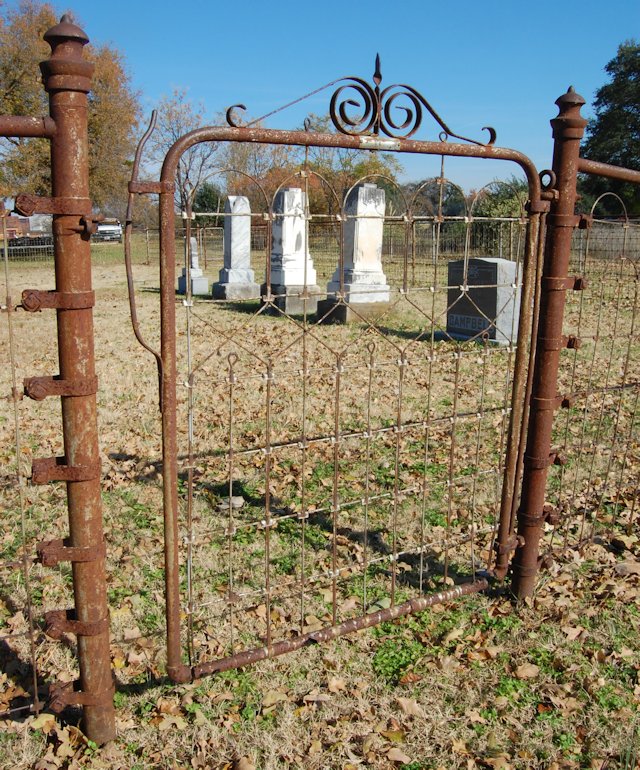 The cemetery was established on farmland of Henry Jack Thompson (1832-1883), who came to Texas in 1854, settling first at Veal’s Station in Parker County and then moving to Jack County. He received a commission as captain in the Texas Rangers in 1861 but fought in the Union army in the Civil War.
The cemetery was established on farmland of Henry Jack Thompson (1832-1883), who came to Texas in 1854, settling first at Veal’s Station in Parker County and then moving to Jack County. He received a commission as captain in the Texas Rangers in 1861 but fought in the Union army in the Civil War.
The Thompson family moved to White Settlement in 1873 and bought two thousand acres stretching from the West Fork of the Trinity River south to Weatherford Road (Highway 80), including land in today’s Westover Hills and Ridglea. Part of the Thompson homestead would become the site of Shady Oaks Country Club in 1958. The Shady Oaks clubhouse is sixteen hundred feet southeast of the cemetery.
 Thompson Family Cemetery is just fourteen hundred feet from Thompson Community Cemetery (see Part 1).
Thompson Family Cemetery is just fourteen hundred feet from Thompson Community Cemetery (see Part 1).
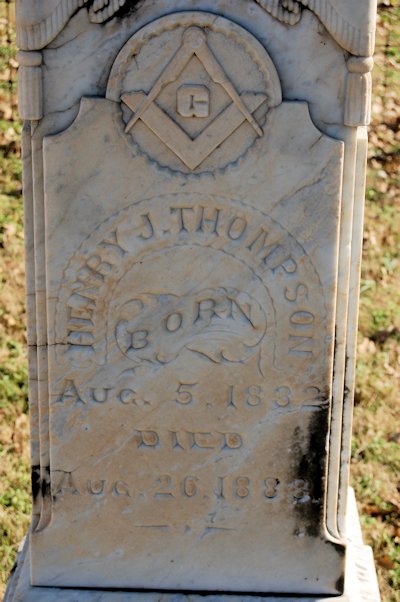 Henry Jack Thompson died in 1883. His burial was the first in the family cemetery.
Henry Jack Thompson died in 1883. His burial was the first in the family cemetery.
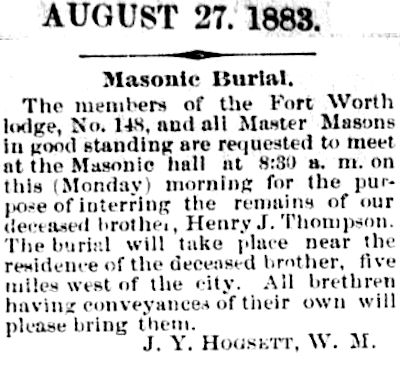 Thompson received a Masonic burial. (J. Y. Hogsett wrote Fort Worth’s first city charter in 1873.)
Thompson received a Masonic burial. (J. Y. Hogsett wrote Fort Worth’s first city charter in 1873.)
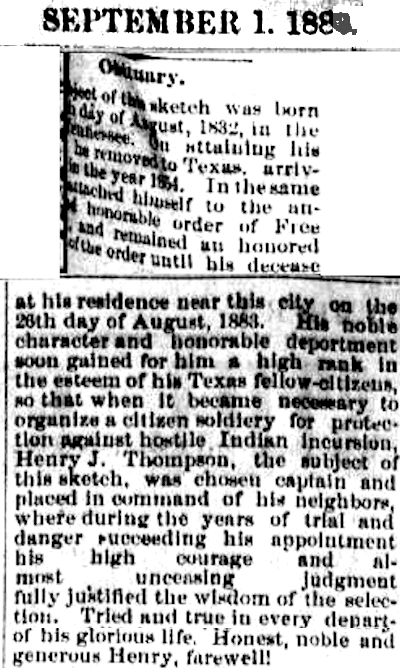 The top of this eulogy in the Fort Worth Gazette was cut off on the edge. It reads: “The subject of this sketch was born on the fifth day of August, 1832, in the state of Tennessee. On attaining his majority, he removed to Texas, arriving early in the year 1854. In the same year he attached himself to the ancient and honorable order of Freemasonry and remained an honored member of the order until his decease . . .”
The top of this eulogy in the Fort Worth Gazette was cut off on the edge. It reads: “The subject of this sketch was born on the fifth day of August, 1832, in the state of Tennessee. On attaining his majority, he removed to Texas, arriving early in the year 1854. In the same year he attached himself to the ancient and honorable order of Freemasonry and remained an honored member of the order until his decease . . .”
The eulogy adds: “When it became necessary to organize a citizen soldiery for protection against hostile Indian incursion, Henry J. Thompson . . . was chosen captain and placed in command of his neighbors. . . . Honest, noble and generous Henry, farewell.”
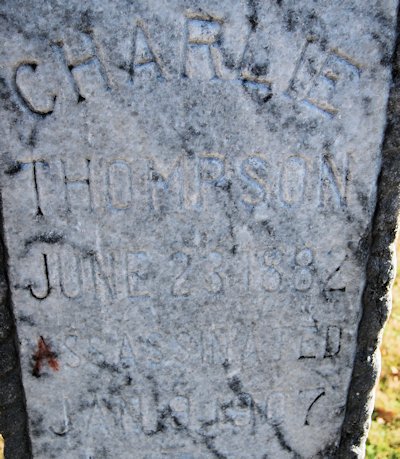 Thompson’s son Charlie did nor fare as well.
Thompson’s son Charlie did nor fare as well.
 The inscription on his tombstone is hard to read. One word is ASSASSINATED.
The inscription on his tombstone is hard to read. One word is ASSASSINATED.
 In 1907 Charlie was shot to death in Rosen Heights by streetcar motorman Clarence Boyd after “some difficulty came up between the two men.”
In 1907 Charlie was shot to death in Rosen Heights by streetcar motorman Clarence Boyd after “some difficulty came up between the two men.”
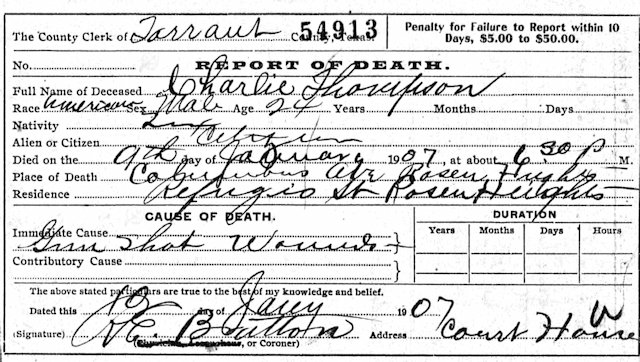 Charlie Thompson was twenty-four years old.
Charlie Thompson was twenty-four years old.
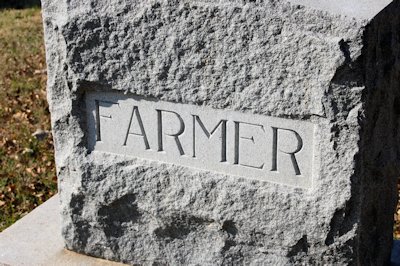 People of the nineteenth century lived in a small world. Their dating pool was even smaller. People married neighbors, people they met at school or at church. Thus, recurring surnames are found in family cemeteries of the era. For example, of the twelve burials in the Thompson Family Cemetery, seven are Thompsons, but three are Farmers because the two families intermarried. The Farmers were prominent settlers of White Settlement.
People of the nineteenth century lived in a small world. Their dating pool was even smaller. People married neighbors, people they met at school or at church. Thus, recurring surnames are found in family cemeteries of the era. For example, of the twelve burials in the Thompson Family Cemetery, seven are Thompsons, but three are Farmers because the two families intermarried. The Farmers were prominent settlers of White Settlement.
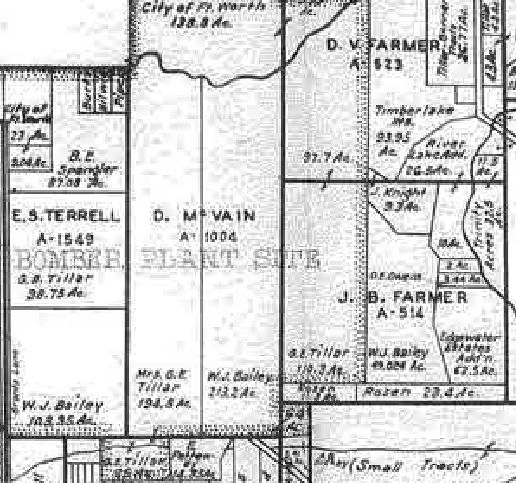
Joseph Beryl and David Vaughn Farmer owned land where the bomber plant would be built. Other landowners there were Ed S. Terrell, William J. Bailey, and Benjamin Johnston Tillar. Joseph Beryl and David Vaughn Farmer were brothers of Press Farmer of Fort Worth’s first family.
The cemetery is located just six hundred feet from Farmers Branch creek.
Willburn and Burke Cemeteries
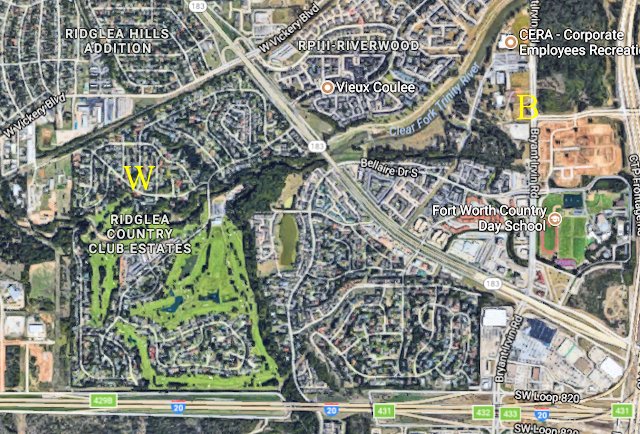 Just as settlers of White Settlement are buried in the Thompson Family Cemetery, four miles to the south settlers of Benbrook and other nearby communities are buried in two family cemeteries: Willburn and Burke.
Just as settlers of White Settlement are buried in the Thompson Family Cemetery, four miles to the south settlers of Benbrook and other nearby communities are buried in two family cemeteries: Willburn and Burke.
 This detail from an 1895 county map shows the town of Benbrook. But the town was not always so-named. Edward (1804-1886) and Nancy Overton Willburn (1811-1889, see Burke Cemetery below) migrated from Missouri to Dallas in 1843 as “Family 107” of Peters Colony. In 1854 the couple moved on westward and settled on Mary’s Creek (see Part 1) north of Benbrook. In 1857 Edward built a one-room schoolhouse and a Methodist church near the Clear Fork of the Trinity River. In 1880 the schoolhouse (see 1895 map) was rebuilt near the intersection of Mercedes Street and Winscott Road in present-day Benbrook on land donated by Rachael Marinda Willburn Snyder (1835-1924), daughter of Edward and Nancy. Marinda donated five acres for the school and a cemetery, which may have been the start of today’s Benbrook Cemetery, established in 1885. The school was named for Marinda, and the community also came to be known as “Marinda.”
This detail from an 1895 county map shows the town of Benbrook. But the town was not always so-named. Edward (1804-1886) and Nancy Overton Willburn (1811-1889, see Burke Cemetery below) migrated from Missouri to Dallas in 1843 as “Family 107” of Peters Colony. In 1854 the couple moved on westward and settled on Mary’s Creek (see Part 1) north of Benbrook. In 1857 Edward built a one-room schoolhouse and a Methodist church near the Clear Fork of the Trinity River. In 1880 the schoolhouse (see 1895 map) was rebuilt near the intersection of Mercedes Street and Winscott Road in present-day Benbrook on land donated by Rachael Marinda Willburn Snyder (1835-1924), daughter of Edward and Nancy. Marinda donated five acres for the school and a cemetery, which may have been the start of today’s Benbrook Cemetery, established in 1885. The school was named for Marinda, and the community also came to be known as “Marinda.”
On the 1895 map “E. Wilburn” probably was Edward Willburn.
 In 1880 James Benbrook (see 1895 map) had persuaded the Texas & Pacific railroad (see 1895 map) to build a station at the Marinda community. The station was named “Benbrook,” and gradually the Marinda community also took on that name. This 1882 clip from the short-lived Fort Worth Democrat-Advance refers to the community as “Benbrook” but to the school as “Miranda” (Marinda).
In 1880 James Benbrook (see 1895 map) had persuaded the Texas & Pacific railroad (see 1895 map) to build a station at the Marinda community. The station was named “Benbrook,” and gradually the Marinda community also took on that name. This 1882 clip from the short-lived Fort Worth Democrat-Advance refers to the community as “Benbrook” but to the school as “Miranda” (Marinda).
 And here lies Rachael Marinda Willburn (1835-1924), wife of John Snyder (1820-1882).
And here lies Rachael Marinda Willburn (1835-1924), wife of John Snyder (1820-1882).
 Marinda is buried in Willburn Cemetery, hidden behind a wooden privacy fence on a residential street in Ridglea Country Club Estates.
Marinda is buried in Willburn Cemetery, hidden behind a wooden privacy fence on a residential street in Ridglea Country Club Estates.
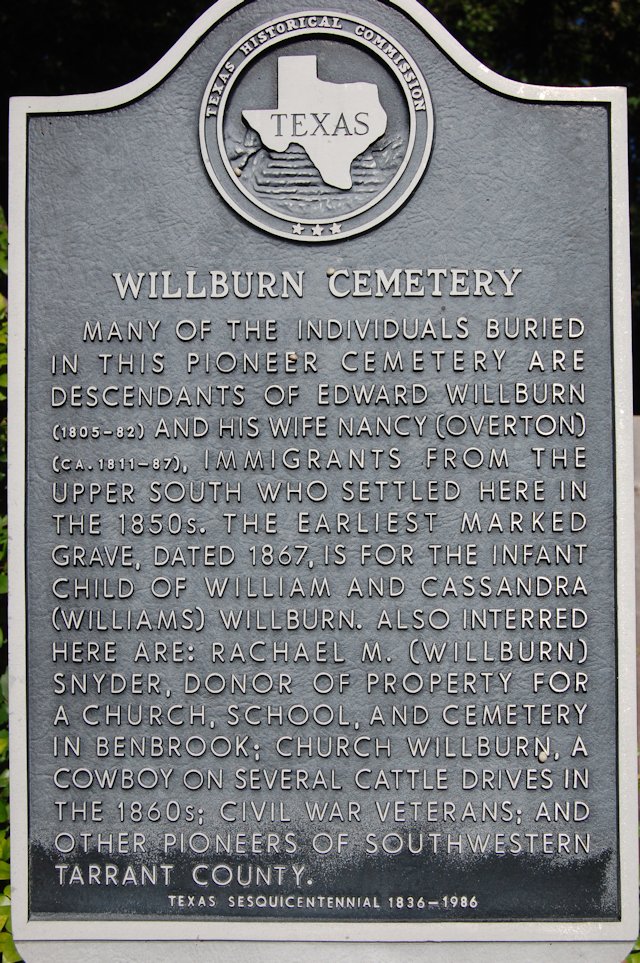 The cemetery, the size of a back yard, contains about twenty grave markers.
The cemetery, the size of a back yard, contains about twenty grave markers.
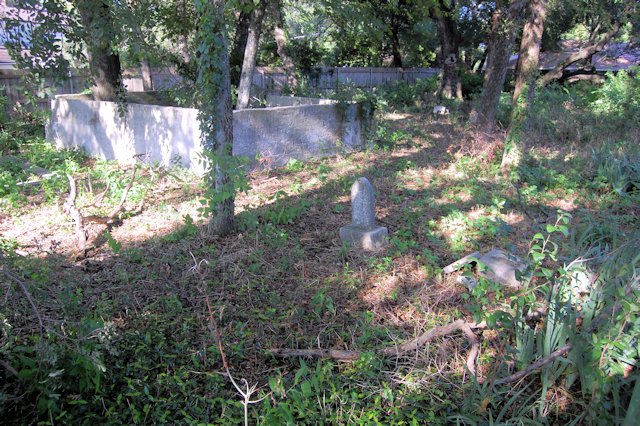 Behind its privacy fence Willburn Cemetery waits for some TLC.
Behind its privacy fence Willburn Cemetery waits for some TLC.
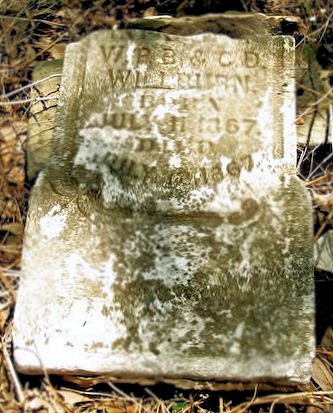 In 1867 the first person buried in the cemetery was the child of William Willburn (1837-1907) and Cassandra Williams Willburn (1848-1920). The infant lived only one day.
In 1867 the first person buried in the cemetery was the child of William Willburn (1837-1907) and Cassandra Williams Willburn (1848-1920). The infant lived only one day.
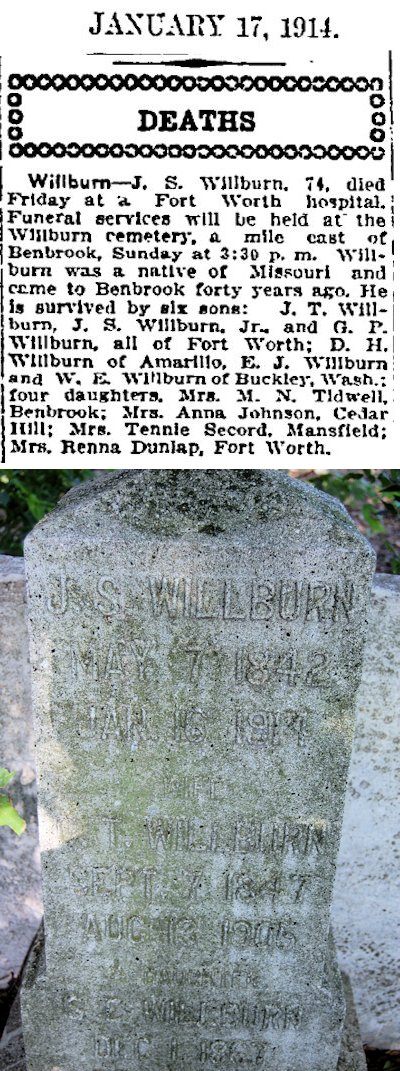 John Sidney Willburn (see 1895 map), born in 1842, died in 1914.
John Sidney Willburn (see 1895 map), born in 1842, died in 1914.
 John C. Leak, who lived less than a year, is one of four Leaks buried in Willburn Cemetery. On the 1895 map H. Leak lived north of Train Robber’s Bridge.
John C. Leak, who lived less than a year, is one of four Leaks buried in Willburn Cemetery. On the 1895 map H. Leak lived north of Train Robber’s Bridge.
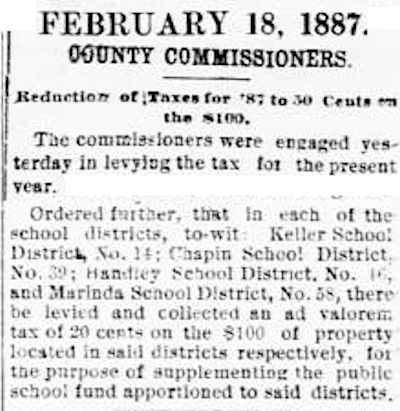 By 1887 the Marinda school had its own district. So did the Chapin school (see Part 1).
By 1887 the Marinda school had its own district. So did the Chapin school (see Part 1).

A mile east of Willburn Cemetery on busy Bryant Irvin Road is Burke Cemetery.
 When it was established in 1867, Burke Cemetery (yellow rectangle) was a long wagon ride from Fort Worth.
When it was established in 1867, Burke Cemetery (yellow rectangle) was a long wagon ride from Fort Worth.

Today half-acre Burke Cemetery is hemmed in by a gas well, Bryant Irvin Road, and the Waterside “lifestyle/mixed-use development.”
 The cemetery was located on the land (probably Peters Colony) owned by Evan H. Burke and settled by his widow, Mary Overton Burke, in 1851.
The cemetery was located on the land (probably Peters Colony) owned by Evan H. Burke and settled by his widow, Mary Overton Burke, in 1851.
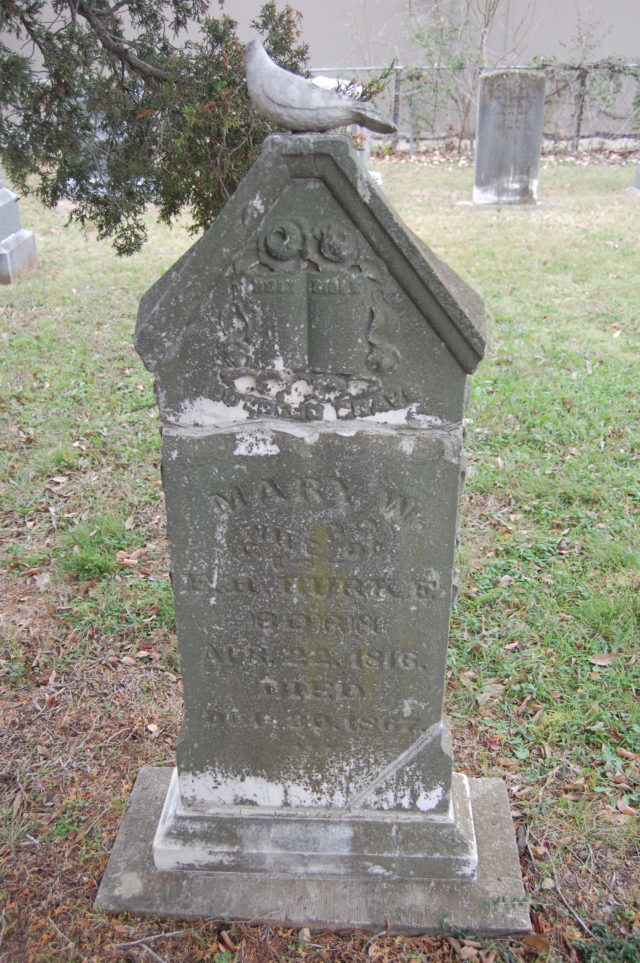
She was the first person buried in the cemetery in 1867. Mary Overton Burke died on December 30.

Two days later Mary’s mother, Rachel Cameron Overton, died.
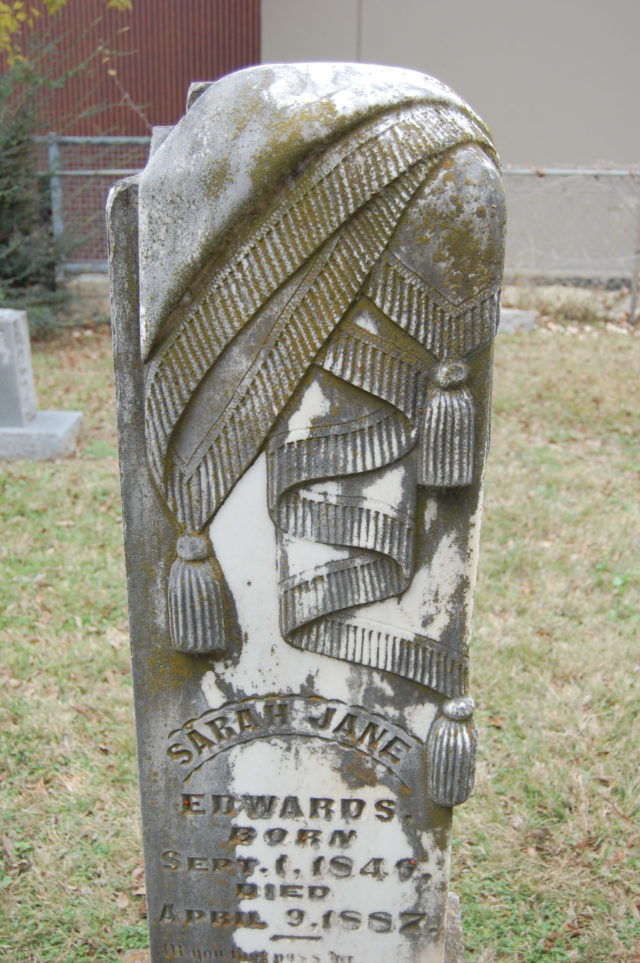 In addition to two Overtons, two Edwardses are buried there. Surely they were relatives of Cass Overton Edwards (1851-1941), who expanded the ranch that his murdered father, Lemuel, had begun in 1848 until it included much of present-day southwest Fort Worth. The cemetery is on or very near former Edwards ranch land.
In addition to two Overtons, two Edwardses are buried there. Surely they were relatives of Cass Overton Edwards (1851-1941), who expanded the ranch that his murdered father, Lemuel, had begun in 1848 until it included much of present-day southwest Fort Worth. The cemetery is on or very near former Edwards ranch land.
Several streets and subdivisions in the area have the name Overton.
 This detail from an 1895 county map shows that Evan H. Burke and Lemuel J. Edwards were neighbors on the Clear Fork.
This detail from an 1895 county map shows that Evan H. Burke and Lemuel J. Edwards were neighbors on the Clear Fork.
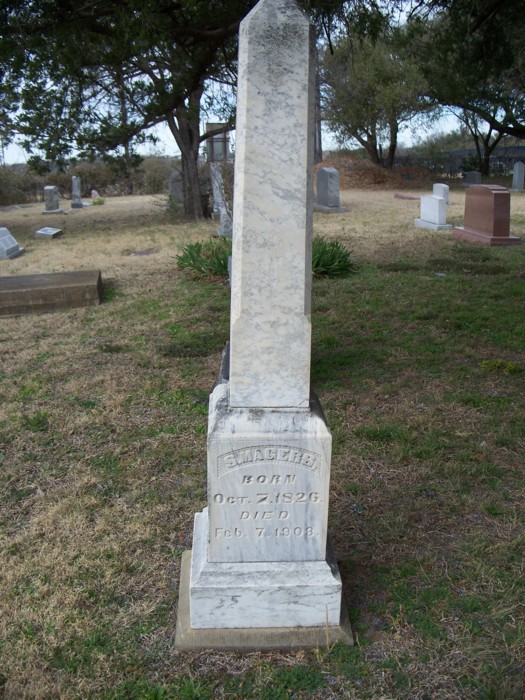 Several members of the Magers family, including Seaton Paschal Magers (see 1895 map), also are buried in Burke Cemetery. Seaton married Nancy Ann Matilda Burke.
Several members of the Magers family, including Seaton Paschal Magers (see 1895 map), also are buried in Burke Cemetery. Seaton married Nancy Ann Matilda Burke.
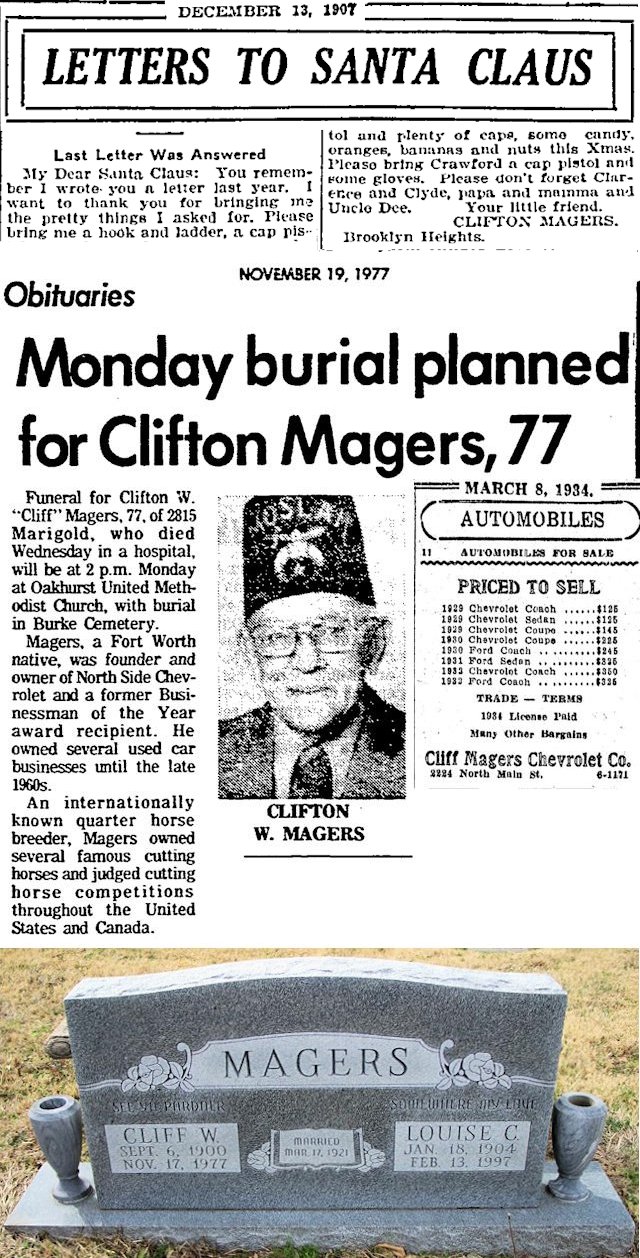 Cliff Magers was seven years old in 1907 when his letter to Santa Claus appeared in the Telegram. He and his brothers Clarence, Clyde, and Crawford, mentioned in the letter, are buried in Burke Cemetery. Magers was a longtime auto dealer in Fort Worth.
Cliff Magers was seven years old in 1907 when his letter to Santa Claus appeared in the Telegram. He and his brothers Clarence, Clyde, and Crawford, mentioned in the letter, are buried in Burke Cemetery. Magers was a longtime auto dealer in Fort Worth.
Islands of Eternity (Part 2): Family First (East Side)
Islands of Eternity (Part 4): Mosier Valley in Memoriam
Posts About Cemeteries
Fort Worth’s Street Gang






do you have any knowledge of the Hawkes Creek Country Club house across from the Thompson Family Cemetery this structure looks very old and castle like I have always wondered if the people in the cemetery were the ones who lived here in the past. Otherwise, I will continue to believe this is the Collins house on Dark Shadows tv series as I thought when I discovered it at the age of 8 back in 1970
That’s the house that Cheerios built–the former home of grain executive Leo Potishman. Been there since 1938.
In the 70’s we found a small cemetery in the woods across the street from the Thompson/Hawks Creek location where there is now Westmore Senior Living and Leonard Trail off of Roaring Springs Road. It looked very similar to the Thompson and Burke sites, with fencing around and a small number of graves contained within. Kids used to ride the trails in those woods a lot and the cemetery was right in the middle about two-hundred yards behind the lake on the north end of Shady Oaks. It was well hidden back then too. I wonder what ever became of it after development in that area in the 90’s?
Terry, usually the population of a cemetery was transferred to another cemetery. A search of the S-T archives for “Westmore Senior” and “cemetery” shows nothing. If that cemetery is in this list I have not found it yet. One problem is that cemeteries often were referred to by more than one name, and people often gave different descriptions for the location of a cemetery.